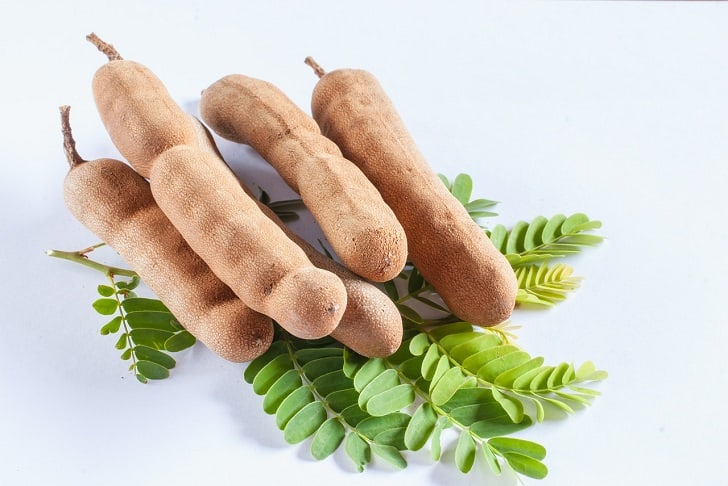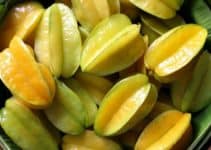Tamarind juice benefits include high in antioxidants, prevents atherosclerosis, rich in magnesium, promotes weight loss, good for nerve function, maintains blood pressure, promotes fluoride excretion, helpful for eyes, purifies the blood, is anti-diabetic, and good for the skin.
Tangy tamarind is also known as the Indian date. Biting into this tropical fruit can feel like divine (only if you like its sweet-sour taste!), so much that you may wonder if this can actually be beneficial for you. The answer is a big “YES!”.
Botanically this tropical African native tree belongs to Fabaceae family, in the genus Tamarindus. The ground leaves, pod-like fruits, and pulp inside tamarinds are edible. In fact, tamarind has a long-standing history as a spice-condiment and folk medicine in South-Asian regions, Mexico, and Africa.
Nutrients Found in Tamarind
Tamarind delivers a host of nutrients which makes eating the tangy fruit a wise choice. One cup of (120 g) tamarind pulp provides:
- Calories: 287
- Protein: 3.4 g
- Carbs: 75 g
- Fat: 0.7 g
- Dietary fiber: 6.1 g
Tamarind is rich in both water-and fat-soluble vitamins, too.
- Thiamine: 34% of the RDI
- Riboflavin: 11% of the RDI
- Niacin: 12% of the RDI
- Vitamin K: 4% of the RDI
- Vitamin C: 7% of the RDI
- Vitamin B6: 4% of the RDI
- Folate: 4% of the RDI
- Pantothenic acid: 2% of the RDI
Speaking of the minerals, here are the nutrient values:
- Potassium: 22% of the RDI
- Iron: 19% of the RDI
- Magnesium: 28% of the RDI
- Phosphorous: 14% of the RDI
- Calcium: 9% of the RDI
It also contains small amounts of zinc, sodium, calcium, and selenium.
13 Phenomenal Health Benefits of Tamarind Juice
1. High in antioxidants
Tamarinds are antioxidant powerhouses. These health-protective compounds are anti-cancerous, anti-diabetic, and heart-friendly. Polyphenols like apigenin, catechin, procyanidin B2, and epicatechin are effective in neutralizing free radicals.
Geraniol, another natural antioxidant in tamarind is linked to suppressing pancreatic tumor. Tartaric acid present in tamarind also shields your cells from free radicals that can lead to chronic diseases.
2. Prevents Atherosclerosis
The antioxidants, fiber, and potassium in tamarind juice help your heart in several ways. In an in vivo study, hypercholesterolemic hamsters fed with tamarind fruit pulp showed reduction in total cholesterol, LDL cholesterol and triglyceride levels. This anti-cholesterol nature is significant in destroying fat plaques that build in the arteries and leads to atherosclerosis. Another study revealed tamarind’s potential in reducing the diastolic pressure.
Turns out, anti-inflammatory nature of tamarind prevents inflammations in heart wall and arteries, too. Plus, it has zero fat – so, don’t worry about your heart getting ‘overloads’ and developing heart diseases.
3. Tamarind is rich in magnesium
Tamarind packs a good amount of magnesium – 110 mg (28% of DV) per 120 g pulp. That means incorporating tamarind juice can make it super easy to meet the daily magnesium requirements. For the starters, this mineral plays a vital role in bone formation, regulating heart rhythm, muscle contractions, and blood sugar control.
Moreover, it is good for individuals with insomnia or sleeping disorders – once again, thanks to tamarind’s magnesium content. Studies show that magnesium is essential for a good night’s sleep. This, in turn, resets the disrupted internal clock and regulates the metabolism.
4. Promotes weight loss
The hydroxycitric acid (HCA) in tamarind has been shown to whittle extra pounds. And, this is good news for people suffering from obesity, the #2 cause of preventable death in America. A recent study actually uncovered some remarkable anti-obese benefits of consuming tamarind. The results show that by inhibiting trypsin (proteolytic enzyme), HAC reduced food intake.
Another study says tamarind may increase serotonin levels in the body to aid weight management. Serotonin controls appetite and helps direct the body whether to burn or store the fat.
5. Good for nerve function
Thiamine and other B-complex vitamins in tamarind are the keys for improving nerve function and maintaining strong refluxes. Studies done by Monash University revealed that xyloglucan in tamarind could help the growth of the damaged brain and spinal cells. Scientist says that xyloglucan can act as a supporting scaffold through which healthy cells migrate and reattach to the nervous system.
Additionally, it improves muscle development as well. So, include some tamarind in your diet every day to stay active and focused.
6. Maintains healthy blood pressure
Tamarind is loaded with potassium but has low sodium. One cup of tamarind contains a whopping 753 mg potassium, compared to just 33.6 mg sodium. Being a great vasodilator, potassium helps the blood vessels relax and maintain proper blood pressure.
7. Promotes fluoride excretion
It seems unlikely that the sour-sweet fruit would flush out fluoride from the body, but that was the conclusion of a study published in the European Journal of Clinical Nutrition. For 18 days, 20 healthy boys ate 10 g tamarind daily. At the end of the study, researchers found that tamarind intake led to increased urinary excretion of fluoride.
This result, in fact, is significant because high fluoride levels translate into low thyroid function, low IQ, infertility, tooth irregularities, cancer, and debilitating bone disease (Sad that the world is after fluoride-filled toothpaste!)
8. Has anti-inflammatory properties
Tamarind is a good anti-inflammatory agent. Tamarind pulp contains lupeol, an anti-cancerous and anti-inflammatory polyphenol that helps to relieve gout and rheumatic conditions. Tamarind juice can also be used in treating inflammatory bowel diseases like ulcerative colitis and Crohn’s diseases.
A 2015 study found tamarind seeds’ anti-arthritic potential and ability to suppress inflammatory markers in the body. Additionally, certain other studies indicate that tamarind can reduce conjunctivitis and other eye irritations arising from corneal inflammation.
9. Purifies the Blood
Tamarind packs over a dozen nutrients including vitamins, antioxidants, dietary fiber, folic acid, and essential minerals. These compounds are essential in scavenging free radicals and canceling out their harmful effect on the circulation and vital organs. Thus, including tamarind juice, chutney or pulp in the diet means your blood remains toxin-free
Tamarind also contains a good amount of iron – 3.4mg/120 g of pulp. When you meet the daily iron requirement, you can keep fatigued and anemia at bay.
10. Helpful For Eyes
Vitamin A in tamarind helps your eyes in several ways. The fat-soluble vitamin, which protects the cornea, has been shown to reduce the risk of developing macular degeneration. The nutrients in tamarind juice can also treat conjunctivitis or lessen the discomfort from excessive illumination. However, there is no direct evidence of its benefits on poor eyesight.
In fact, researchers found mucin-like substance in tamarind that helps with eye dryness. Mucin is the substance in our eye that hydrates and protects the cornea. Now you know why tamarind is used in eye drops, right?
11. Natural Laxative
Drinking tamarind juice in the morning relieves constipation. This is due to its dietary fiber content – 6.1 g/120 g of pulp. Dietary fiber not only promotes bowel movements but supports natural fermentation in the gut. Studies have found that compounds in tamarind also promotes bile activity to dissolve food faster and speeds up digestion.
A study published in the Journal of Food and Chemical Toxicology says tamarind has chemoprotective activity against colon cancer.
12. It is anti-diabetic, too
The sweet-sour tamarind juice is a natural remedy for diabetes. It basically inhibits alpha-amylase, the enzyme that prevents carbohydrate absorption. Moreover, scientists revealed that being rich in magnesium, tamarind juice can effectively control type-2 diabetes.
When consumed regularly, tamarind juice can also protect the pancreas from oxidative damage which is commonly seen in diabetic patients.
13. Good for your skin
Ever wondered what happens to the skin tamarind juice is applied topically? Your skin becomes spot-free and radiant! It is a great source of alpha hydroxy acids (AHA), a key ingredient in top-rated exfoliators out there. This means you can use the juice as an exfoliator to reveal healthy, rejuvenated skin.
Antioxidants and vitamin C present in tamarind juice combat free radicals and prevents premature aging, too.
How to consume more tamarind juice?
Luckily, tamarind is easy to incorporate into food and drinks. For example, you can use tamarind juice to flavor meat, fish, or rice dishes just like Indians do. Tamarind candy is a famous treat in Jamaica and Cuba. Tamarind also makes a savory addition to various dips and chutneys. You can also use it to make tropical drinks or carbonated beverage. The choice is yours!
Word of caution
- The major concern is that it interferes with blood clotting as it is a blood thinner. Hence not recommended for individuals who are on aspirin and other blood thinners.
- It may elicit an allergic reaction in certain individuals
- If you are diabetic and use tamarind juice regularly, closely monitor your sugar levels. Because tamarind can cause hypoglycemia.
- If you’re suffering from gallstones, it’s better to limit tamarind intake as it may worsen gallstones.
- Being acidic in nature, it can spike up the levels of gastric juices and cause GERD or acid reflux.
The Bottom Line
Tamarind is rich in vitamins, mineral, anti-inflammatory compounds, and antioxidants and has been associated with many health benefits, including improved immunity, digestive, heart, liver, eye, and nerves’ health. It is also said to have potential anti-cancerous, antimicrobial and anti-inflammatory benefits.
Best of all, it’s easy to add to your diet as part of drinks, meals, dipping, marinade or sauces.






